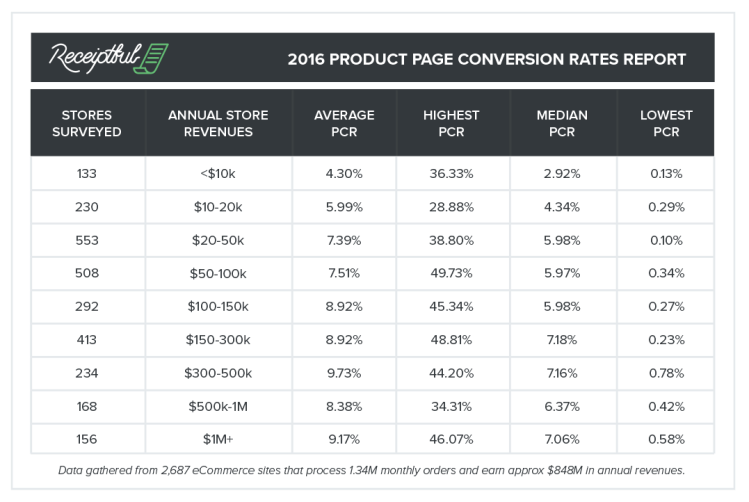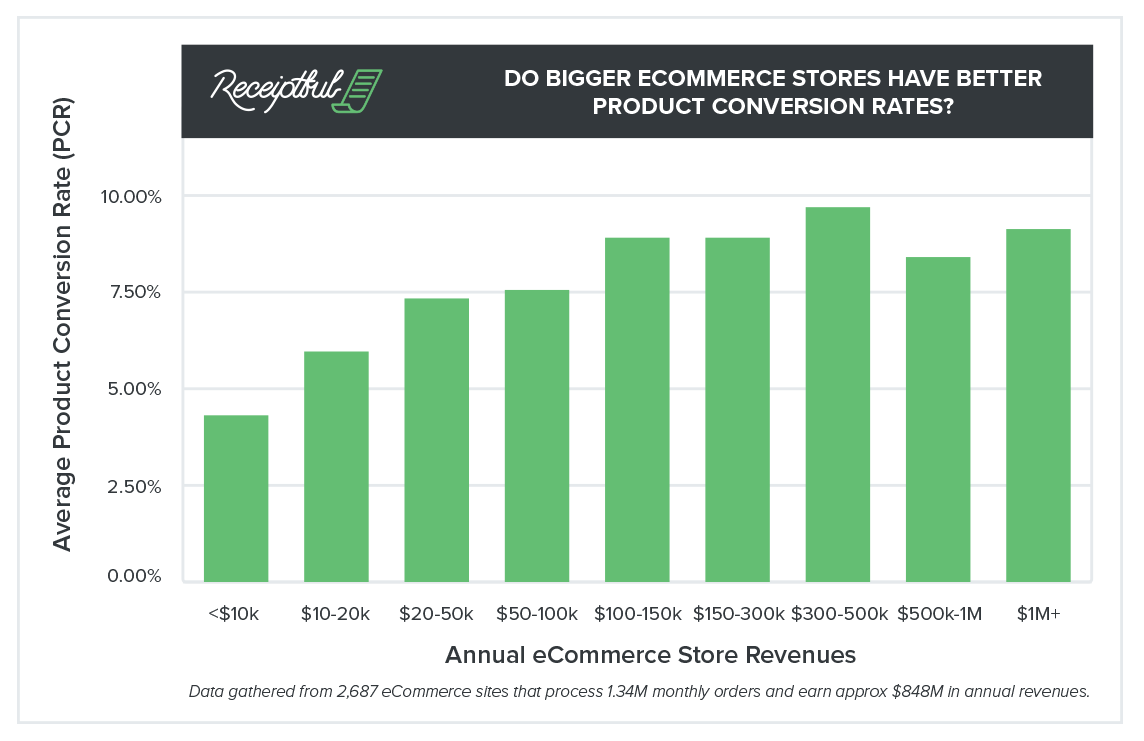Ecommerce is all about getting visitors to click the elusive ‘buy now’ button. And it is big business too.
By 2019, according to eMarketer estimates, 9.8 percent of U.S. retail sales will be transacted over the Internet — which equates to around $550 million. In Europe and Asia-Pacific, the online piece of the retail pie is even higher.
Understanding this space is important for anyone selling products online, however, most research into average conversion rates has been conducted on a site-wide basis. To really understand the benchmarks, it makes sense to look at the conversions rate per product page.
That’s exactly what Receiptful has done, and today it’s launching its 2016 Product Page Conversion Rates report.
With many homepages seeing a drop in traffic due to long-tail searches and social sites leading directly to product pages, how important is it to track product page conversion rates?
“Indeed, the homepage is not what it used to be,” Receiptful’s Danny Wong told me. “Shoppers increasingly enter stores through everything but the front door. Product pages are no longer just a mid-funnel milestone in a shopper’s journey. In some cases, product pages are the first point of interaction a customer has with a brand (case in point: product listing ads). Therefore, stores may want to ensure their product pages are engaging, standalone assets.”
Gathering data from 2,687 ecommerce sites, which took in 1.34 million receipts each month and represent an estimated $848 million in annual sales, Receiptful found that the average page conversion rate (PCR) is 7.91 percent. The average store surveyed sells approximately $315,600 worth of product every year.
Breaking those results down by business size, it is clear the stores that generate over $100,000 in annual revenues see significantly better results than do smaller ecommerce businesses.
Receiptful puts this down to the smaller businesses not using conversion rate optimization (CRO) tools, but could sheer traffic and brand awareness also be a factor, especially since many CRO products are free to use for smaller organizations?
“I would be hesitant to say that audience size is the biggest differentiator between SME and enterprise ecommerce stores,” Wong responded. “That said, you are onto something. Larger ecommerce stores have more marketing firepower than small online shops; either they have built a popular brand that earns a lot of organic traffic or they have a sophisticated paid marketing strategy that targets the right consumers (or both!). And while they might not directly invest in CRO, other brand and marketing efforts tend to have a positive effect on conversions. Off-site campaigns, such as earned media placements through PR, email promotions, and product listing ads can drive highly targeted traffic that is more likely to convert.”
Wong believes that while the tools are accessible, annual revenues affect a company’s ability to utilize them properly.
“While all stores have access to the same tools for CRO, they may not have the same human or design resources to effectively utilize those tools,” Wong said. “Solopreneurs may be inundated with product fulfillment tasks and customer service requests, leaving only a few hours a month to actively A/B test product page designs and landing pages. Furthermore, creating new designs and visuals can be costly, which may bite into a small store owner’s already thin margins. Larger stores, on the other hand, can afford to run more regular CRO campaigns.”
So why is it important to measure PCR?
“Product page conversion rates offer additional insight that can help ecommerce stores improve their conversion funnel,” Wong said. “For example, if a store notices it has a high PCR but a low site-wide conversion rate, that may mean a large portion of the store’s visitors merely window shop. The actionable takeaway here would be that the store should invest in efforts that drive more of its shoppers to actually click and view its products.”
And what else did Wong discover in the data that surprised him?
“Of the 2,687 stores we surveyed, 52 had a 30 percent PCR or higher, 151 had a PCR of 20 percent or higher, and 690 (almost 26 percent) had a PCR of 10 percent or higher,” Wong said. “That’s incredible to me. The ecommerce ‘unicorns’ have indeed cracked the code for converting product page visits into sales.”
The full report is available today from Receiptful, where you’ll find complete breakdowns of high, low, average, and median PCR by annual revenue.
VentureBeat's mission is to be a digital town square for technical decision-makers to gain knowledge about transformative enterprise technology and transact. Learn More


